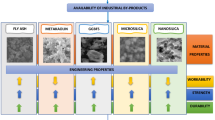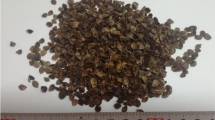Abstract
Large quantities of solid wastes are being generated worldwide which lead to environmental concerns. One such major component is tin cans. Utilization of tin cans wastes in making building construction materials can reduce the magnitude of many associated problems. “Energy Block” is a type of block which has high energy absorption when kept under load. It is mainly composed of cement, sand, fibers, and tin cans. This paper shows the energy block is an environment friendly and lightweight building block from cement mortar, waste tin cans and fibers, without the use of coarse aggregate providing high energy absorption to the concrete. The paper concludes the results of laboratory tests and the actual behavior and performance of such building materials in practical application providing lightweight and the usage of tin cans can be economical for conservation of environment.
Access this chapter
Tax calculation will be finalised at checkout
Purchases are for personal use only
Similar content being viewed by others
References
Fanella, D.A., Naaman, A.: Stress strain properties of fiber reinforced mortar in compression. ACI J 82(4), 475–483 (1985)
Abrishami, H.H., Mitchell, D.: Influence of steel fibers on tension stiffening. ACI Struct J 94, 769–776 (1997)
Kukreja et al.: Ultimate strength of fiber reinforced concrete slabs. In: Proceedings International Symposium of Fiber Reinforced Concrete, pp. 237–255. Madras, 1 (1987)
Zollo, R.F.: Fiber reinforced concrete: an overview after 30 years of development. Cem. Concr. Compos. 19, 107–122 (1997)
Ravinder, K.: Strength characteristics of coca-cola tin waste as fibres in concrete. Int. J. Adv. Res. Found. 3(2), 9–12 (2016)
Acknowledgements
We would like to place on record, our grateful thanks to SRM University for providing all facilities and help in carrying out this project. We are extremely grateful to Dr. K. S. Satyanarayanan, Professor and Head, Department of Civil Engineering for the encouragement and support provided during the project work. Also, we would like to thank Mr. S. Srinivasa Senthil, our sub-guide for the valuable guidance from the beginning to the end.
Author information
Authors and Affiliations
Corresponding author
Editor information
Editors and Affiliations
Appendix
Appendix
-
Quantity Estimate
-
The volume of a single block is πr2h = π × 752 × 300
-
=5301.4 × 103 mm3
-
=5301.4 mL
-
Therefore volume of mortar in cylinder with plain mortar only
-
=5301.4 mL = 0.005301 m3
-
Fiber content added in one block is 0.75% of the volume of the mortar filled in cylindrical block.
-
0.75% × 5301.4 cm3 = 40 g for cylinder with plain mortar and fiber only
-
Therefore volume of fiber used
-
=40/8.05 (since density of steel = 8.05 g/cm3) = 4.97 cm3
-
=4.97 mL
-
Volume of mortar in cylinder with mortar + fiber
-
=5301.4 − 4.97
-
=5296.43 mL = 0.005296 m3
-
Volume of mortar in cylinder with mortar + tin
-
=5301.4 − 500
-
=4801.4 mL = 0.004801 m3
-
For the cylinder having plain mortar, tin and fiber, mass of fiber used is calculated in following steps
-
Volume of plain mortar
-
=[volume of cylinder − volume of tin cans]
-
=5301.4 − 500
-
=4801.4 mL (reduced volume)
-
Mass of fiber used
-
=0.75% of 4801.4
-
=(0.75/100) × 4801.4
-
=36 g
-
Volume of fiber
-
=36/8.05 = 4.47 cm3 = 4.47 mL
-
Therefore volume of total mortar is used in cylinder
-
=(volume of cylinder − volume of tin cans − volume of fiber)
-
=5301.4 − 500 − 4.47
-
=4796.92 mL = 0.004797 m3
-
Details of Cost Estimation
-
Total volume of cylinder = 0.0053 m3
-
Volume of mortar in plain mortar cylinder
-
=0.0053 m3
-
As cement:sand = 1:3
-
Therefore quantity of cement
-
=[0.0053014/(1 + 3)] = 0.001325 m3
-
Density of cement = 1440 kg/m3
-
1 bag of cement = 50 kg of cement
-
Volume of cement = 50/1440 = 0.0347 m3
-
Therefore for volume of 0.001325 m3
-
=[(50/0.0347) * 0.001325]
-
=1.9 kg of cement for 1 cylinder
-
Therefore for the plain mortar cylinder the volume of mortar used is 1.9 kg
-
1 bag = 50 kg of cement = Rs. 375
-
1.9 kg = [(375/50) * 1.9]
-
=Rs. 14.25 (cement price)
-
Volume of sand = 3 * 0.001325 = 0.003975 m3
-
0.0283 m3 = Rs. 43
-
Therefore for 0.14037 m3 = [(43/1) * 0.14037]
-
=Rs. 6.036 (sand price)
-
Total price = 14.25 + 6.036
-
=Rs. 20.286 (for plain mortar cylinder)
-
For 1 m3 = [20.286/0.0053014]
-
=Rs. 3826.54
-
Similarly,
-
Volume of mortar used in cylinder filled with plain mortar + fiber only
-
=0.005296 m3
-
Therefore volume of cement used
-
=[0.005296/(1 + 3)]
-
=0.001324 m3
-
Quantity of cement used in cylinder
-
=0.001324/0.0347
-
=0.0382 bags
-
1 bag = 50 kg
-
Therefore 0.0382 bag = 1.91 kg for 1 cylinder
-
1 bag = 50 kg of cement = Rs. 375
-
Therefore for 1.91 bag = Rs. 14.325
-
Volume of sand = 3 * 0.001324
-
=0.00397 m3
-
0.0283 m3 = Rs. 43
-
Therefore for 0.00397 m3 = Rs. 6.032
-
Quantity of fiber used = 4.97 mL = 0.04 kg
-
1 kg of fiber = Rs. 150
-
Therefore for 0.04 kg = Rs. 6
-
Total cost of 1 cylinder
-
=[14.325 + 6.032 + 6]
-
=Rs. 26.357
-
For 1 m3 = [26.357/0.0053014]
-
=Rs. 4971.71
-
Now estimation for cylinder with plain mortar + tin cans only
-
Volume mortar used in cylinder
-
=0.0048 m3
-
Quantity of cement used
-
=[0.0048/(1 + 3)]
-
=0.0012 m3
-
Quantity of cement in bag
-
=[0.0012/0.0347]
-
=0.0346 bags
-
1 bag of cement = 1.73 kg
-
For 0.0346 bags = 1.73 kg
-
1 bag = 50 kg = Rs. 375
-
For 1.73 kg = Rs. 12.975
-
Quantity of sand used
-
=3 * 0.0012
-
=0.0036 m3
-
0.0283 m3 = Rs. 43
-
For 0.0036 m3 = Rs. 5.4667
-
Total cost of a cylinder
-
=[5.4667 + 12.975]
-
=Rs. 18.4417
-
For 1 m3 = [18.447/0.0053014]
-
Now estimation for cylinder with all mortar, fiber and tin cans
-
Volume of mortar used
-
=0.004797 m3
-
Quantity of cement used
-
=[0.004797/(1 + 3)]
-
=0.001199 m3
-
Quantity of cement in term of bag
-
=0.001199/0.0347
-
=0.03455 bags
-
1 bag = 50 kg
-
Therefore in 0.03455 bags = 1.7277 kg
-
1 bag = 50 kg = Rs. 375
-
For 1.7277 kg = Rs. 12.957
-
Quantity of sand used in cylinder = 0.001199 * 3
-
=0.003597 m3
-
0.0283 m3 = Rs. 43
-
Therefore in 0.003597 m3 = Rs. 5.46
-
Now quantity of fiber used = 4.97 mL = 0.04 kg
-
1 kg = Rs. 150
-
Therefore in 0.04 kg = Rs. 6
-
Total cost of a cylinder = [12.957 + 5.46 + 6] = Rs. 24.417
-
For 1 m3 = [24.417/0.0053014]
-
=Rs. 4605.76
Rights and permissions
Copyright information
© 2019 Springer Nature Singapore Pte Ltd.
About this paper
Cite this paper
Jaiswal, R.K., Solanki, N.S., Satish, S., Satyanarayanan, K.S. (2019). High Energy Absorbent Sustainable Concrete Element From Used Tin Cans. In: Kalamdhad, A., Singh, J., Dhamodharan, K. (eds) Advances in Waste Management . Springer, Singapore. https://doi.org/10.1007/978-981-13-0215-2_39
Download citation
DOI: https://doi.org/10.1007/978-981-13-0215-2_39
Published:
Publisher Name: Springer, Singapore
Print ISBN: 978-981-13-0214-5
Online ISBN: 978-981-13-0215-2
eBook Packages: Earth and Environmental ScienceEarth and Environmental Science (R0)




